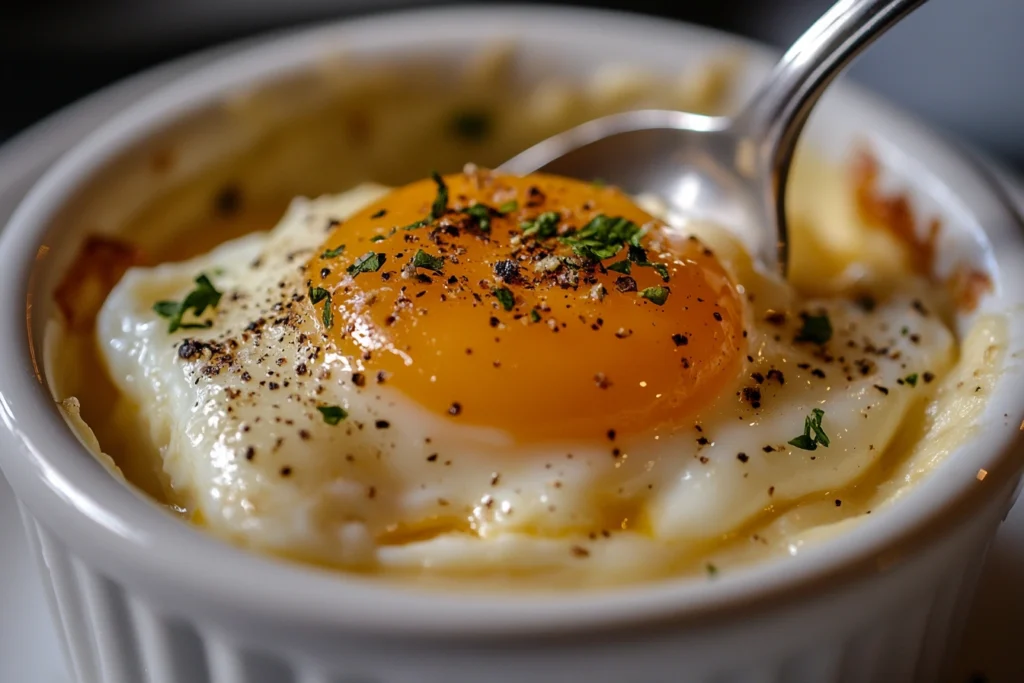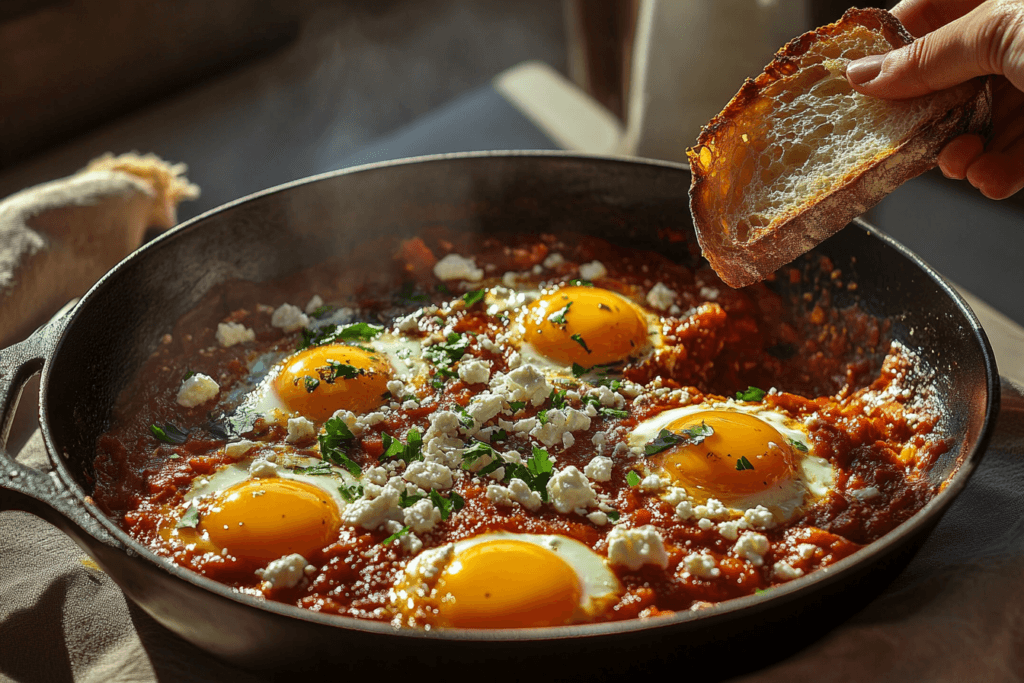Baked eggs are a simple yet versatile dish enjoyed worldwide, whether as a quick breakfast or an elegant brunch option. However, achieving the ideal texture can be tricky, and many home cooks end up with rubbery baked eggs. This article will unravel the science behind this common problem and provide practical solutions to create soft, creamy baked eggs every time.
Brief Overview of Baked Eggs
Baked eggs are prepared by gently cooking them in an oven, often with added ingredients like cream, cheese, or vegetables. While the process sounds straightforward, errors in technique can lead to disappointing results. Rubbery baked eggs are the bane of many cooks, but understanding the causes can help you avoid them altogether.

Table of Contents
Common Issues with Baked Eggs
Several factors contribute to baking mishaps, such as improper temperature, overcooking, and using unsuitable ingredients. These missteps often result in rubbery baked eggs, which lack the creamy consistency most people desire.
Understanding Egg Composition
The Science Behind Eggs: Proteins and Fats
Eggs are primarily composed of water, proteins, and fats. When exposed to heat, the proteins in eggs coagulate, changing from liquid to solid. The fats, meanwhile, add richness to the texture. However, an imbalance in how these components interact often leads to rubbery baked eggs.
How Eggs Change When Heated
As eggs heat up, the proteins form a network that traps water and fat molecules. If overexposed to heat, the proteins tighten too much, squeezing out water and causing a tough, rubbery texture. Managing this process is key to avoiding rubbery baked eggs.
Overcooking: The Main Culprit
Why Overcooking Makes Eggs Rubbery
Overcooking is the most common reason for rubbery baked eggs. Prolonged exposure to high temperatures causes the proteins in eggs to become excessively firm, resulting in a chewy consistency.
Signs of Overcooked Baked Eggs
- A cracked or dry surface
- Tough, bouncy texture
- Discoloration, such as browning or greyish yolks
Avoiding these issues requires careful monitoring during the baking process.
Temperature Matters
The Ideal Baking Temperature for Eggs
Cooking eggs at a moderate temperature is crucial to avoid rubbery baked eggs. The optimal range is between 325°F and 350°F (160°C–175°C). Lower temperatures allow the proteins to set gently, creating a tender texture.
How to Monitor and Control Oven Temperature
An oven thermometer is essential for precision. Built-in temperature controls can be inaccurate, leading to unexpected results. Check the thermometer periodically to ensure even cooking and reduce the risk of rubbery baked eggs.
Cooking Time: Striking the Right Balance

Recommended Baking Times for Different Egg Dishes
Cooking times vary depending on the type of dish:
- Individual ramekins: 12–15 minutes
- Large casseroles: 20–25 minutes
These guidelines help maintain the perfect texture and prevent rubbery baked eggs.
Importance of Checking Eggs Periodically
Always check eggs a few minutes before the expected cooking time ends. This simple habit can save your dish from becoming another case of rubbery baked eggs.
Choice of Ingredients
The Role of Milk or Cream in Baked Eggs
Adding milk or cream enhances the dish’s texture by creating a smoother, richer mixture. This step reduces the likelihood of ending up with rubbery baked eggs.
For more insights into ingredient substitutions, check out healthy and tasty alternatives for oil in baking.
How Other Ingredients Affect Texture
Ingredients like vegetables, meats, or cheeses can release water during baking. Too much moisture can dilute the eggs, while too little can cause them to set too firmly, leading to rubbery baked eggs.
Type of Dish Used
Heat Conduction in Different Baking Dishes
The material of your baking dish influences how heat is distributed. Ceramic or glass dishes are ideal for even cooking, while metal pans can overheat and increase the risk of rubbery baked eggs.
Choosing the Right Material for Egg Recipes
Stick to dishes with good heat retention properties. This ensures your eggs cook uniformly and minimizes texture issues.
Common Baking Techniques to Avoid Rubbery Texture
Preheating the Oven
Preheating ensures the eggs begin cooking at the right temperature immediately, reducing inconsistencies. Starting with a cold oven can lead to uneven cooking and rubbery baked eggs.
Using a Water Bath
Placing your dish in a water bath adds moisture to the cooking environment, preventing the eggs from drying out. This simple technique is a game-changer for avoiding rubbery baked eggs.
Perfecting the Recipe
Popular Baked Egg Recipes and Tips
- Eggs en Cocotte: Use cream for a luxurious texture.
- Shakshuka: Bake eggs in a tomato sauce base for added moisture and flavor.
Adding Flavors Without Ruining the Texture
Avoid overloading with dry spices. Instead, use fresh herbs or a light sprinkle of seasoning to maintain balance and avoid rubbery baked eggs.
Mistakes to Avoid
Using Too High Heat
Excessive heat is one of the most common reasons for rubbery baked eggs. When eggs are exposed to high temperatures, the proteins in them firm up too quickly, squeezing out moisture and creating a tough, chewy texture. This process not only affects the consistency of the eggs but can also cause them to brown or develop an unappealing crust on the surface. To avoid this, always stick to moderate temperatures, ideally between 325°F and 350°F (160°C–175°C). This ensures the eggs cook slowly and evenly, preserving their creamy, soft texture. Using an oven thermometer can help maintain precise heat levels, as many ovens tend to run hotter than their settings indicate.
Overloading the Dish with Ingredients
Adding too many ingredients to your baked eggs might seem tempting, especially when trying to create a hearty meal. However, an overloaded dish can disrupt the delicate balance of the recipe. Excess ingredients, such as vegetables, meats, or cheeses, may release moisture unevenly during cooking, causing the eggs to set improperly. The result? Rubbery baked eggs with pockets of overcooked or undercooked areas. To prevent this, keep your ingredient additions minimal and complementary. Choose a few well-paired items, such as sautéed spinach, diced tomatoes, or shredded cheese, and ensure they are evenly distributed to allow the eggs to cook uniformly. Simplicity often leads to the best results in baked egg recipes.
Testing for Doneness

How to Know When Baked Eggs Are Perfectly Cooked
Look for slightly jiggly centers. Eggs continue cooking after being removed from the oven, so taking them out a bit early prevents rubbery baked eggs.
Tools and Methods to Test Doneness
- Use a toothpick or skewer: It should come out with slight resistance.
- Instant-read thermometer: Aim for 160°F (70°C).
Customizing Texture: Soft vs. Firm Eggs
Achieving the ideal texture for baked eggs often depends on personal preference. Some people enjoy soft, creamy eggs, while others prefer a firmer consistency. Adjusting baking times and ingredients can help you cater to different tastes without risking rubbery baked eggs.
For soft eggs, reduce baking time and use lower heat to slow the protein-setting process. Adding a touch of cream or milk can further soften the texture. Conversely, for firmer eggs, increase the cooking time slightly and use less liquid in the recipe. However, always monitor the oven closely, as overcooking can lead to rubbery baked eggs.
Experiment with ingredient ratios and time to find the perfect balance. Keep in mind that external factors, such as oven accuracy and the type of dish, can also influence the outcome.
Adapting Recipes to Dietary Needs
Dietary needs or preferences can often impact how you prepare baked eggs. Whether you’re catering to a low-fat diet, a high-protein plan, or avoiding dairy, it’s essential to modify recipes thoughtfully to avoid rubbery baked eggs.
- Low-fat options: Skip cream and use water or a light milk alternative.
- High-protein meals: Incorporate egg whites instead of whole eggs.
- Dairy-free recipes: Opt for plant-based milks or creamy vegetables like pureed cauliflower.
When making substitutions, maintain the liquid-to-egg ratio to ensure the dish doesn’t dry out. This balance is crucial to prevent rubbery baked eggs while accommodating dietary restrictions.
Rescuing Rubbery Eggs
Tips to Salvage Overcooked Baked Eggs
If your baked eggs turn out rubbery, all is not lost. Instead of discarding them, you can repurpose the dish creatively. While overcooked eggs won’t regain their original texture, adding moisture and transforming them into another recipe can make them more palatable.
- Dice the overcooked eggs and mix them with mayonnaise for a quick egg salad.
- Incorporate the eggs into a vegetable stir-fry for added protein.
- Blend them into a creamy soup to mask the texture.
These methods help you salvage a meal and reduce food waste, even when faced with rubbery baked eggs. Learn how to enhance your dish with ideas from this collection of recipes.
Transforming Mistakes into Other Dishes
Rubbery eggs can become part of other satisfying dishes. For instance:
- Breakfast burritos: Dice and mix with salsa, cheese, and beans.
- Frittata rescue: Add vegetables, cheese, and more eggs to balance the texture.
- Stuffed peppers: Use overcooked eggs as part of the filling.
Creativity in the kitchen can turn rubbery baked eggs into a culinary opportunity.
Expert Advice for Beginners

Common Challenges and How to Overcome Them
Beginners often face several challenges when baking eggs, including uneven cooking, setting the wrong temperature, or choosing unsuitable ingredients. These mistakes frequently result in rubbery baked eggs.
One common issue is neglecting to preheat the oven, leading to uneven cooking. Another is overcomplicating the recipe with too many ingredients, which can impact the eggs’ texture. To overcome these, start simple and follow proven recipes. As you gain experience, experiment gradually while paying attention to cooking times and temperatures.
Trusted Tips from Professional Chefs
Professional chefs recommend the following for avoiding rubbery baked eggs:
- Use fresh eggs, as older ones tend to cook unevenly.
- Incorporate a small amount of cream or milk to maintain moisture.
- Cook at a consistent temperature of 325–350°F (160–175°C).
- Remove the eggs slightly before they appear done, as residual heat will finish cooking them.
These expert strategies can guide even beginners to success.
Conclusion
Understanding the science behind eggs and making small adjustments to cooking techniques can help you avoid rubbery baked eggs. Always cook at moderate temperatures, monitor the baking process, and experiment with ingredients to achieve your desired texture. With practice and attention to detail, perfectly baked eggs are within reach.
FAQs
1. What causes baked eggs to become rubbery?
Overcooking, high heat, and improper ingredient ratios are the main culprits behind rubbery baked eggs.
2. How can I ensure my baked eggs stay creamy?
Cook at a moderate temperature, monitor the oven closely, and add a splash of cream or milk to the recipe.
3. Can I use plant-based milk in baked egg recipes?
Yes, but choose unsweetened options to avoid altering the flavor and texture.
4. Is there a way to salvage overcooked baked eggs?
Uneven cooking is often due to not preheating the oven or using a baking dish that conducts heat poorly.
5. Why are my eggs cooked unevenly in the oven?
Uneven cooking is often due to not preheating the oven or using a baking dish that conducts heat poorly.


6 thoughts on “Rubbery Baked Eggs: Causes and Fixes for Perfect Results”